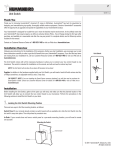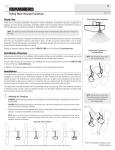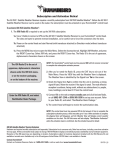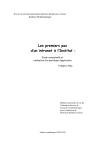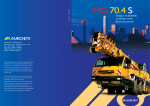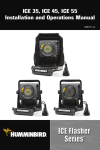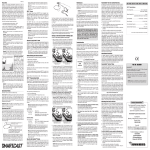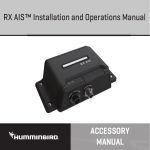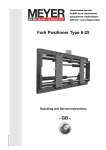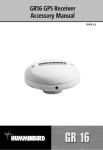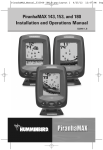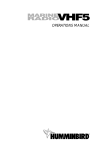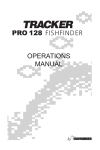Download HHRP 11 and HHRP 17 Installation Manual HHRP 11 and HHRP 17
Transcript
HHRP 11 and HHRP 17 Installation Manual 532028-2_A Thank You! Thank you for choosing Humminbird®, the #1 name in Fishfinders. Humminbird® has built its reputation by designing and manufacturing topquality, thoroughly reliable marine equipment. Your Humminbird® accessory is designed for trouble-free use in even the harshest marine environment. In the unlikely event that your Humminbird® accessory does require repairs, we offer an exclusive Service Policy - free of charge during the first year after purchase, and available at a reasonable rate after the one-year period. For complete details, see the separate warranty card included with your accessory. We encourage you to read this manual carefully in order to get full benefit from all the features and applications of your Humminbird® product. Contact our Customer Resource Center at 1-800-633-1468 or visit our Web site at humminbird.com. W ARNING! Disassembly and repair of this electronic unit should only be performed by authorized service personnel. Any modification of the serial number or attempt to repair the original equipment or accessories by unauthorized individuals will void the warranty. W ARNING! This product contains chemicals known to the State of California to cause cancer and/or reproductive harm. N OTE: To purchase accessories for your control head, visit our Web site at humminbird.com or contact our Customer Resource Center at 1-800-633-1468. N OTE: Product specifications and features are subject to change without notice. Environmental Compliance Statement: It is the intention of Johnson Outdoors Marine Electronics, Inc. to be a responsible corporate citizen, operating in compliance with known and applicable environmental regulations, and a good neighbor in the communities where we make or sell our products. WEEE Directive: EU Directive 2002/96/EC “Waste of Electrical and Electronic Equipment Directive (WEEE)” impacts most distributors, sellers, and manufacturers of consumer electronics in the European Union. The WEEE Directive requires the producer of consumer electronics to take responsibility for the management of waste from their products to achieve environmentally responsible disposal during the product life cycle. WEEE compliance may not be required in your location for electrical & electronic equipment (EEE), nor may it be required for EEE designed and intended as fixed or temporary installation in transportation vehicles such as automobiles, aircraft, and boats. In some European Union member states, these vehicles are considered outside of the scope of the Directive, and EEE for those applications can be considered excluded from the WEEE Directive requirement. i © rs. pry nt. rs, ar od. ur ull t. This symbol (WEEE wheelie bin) on product indicates the product must not be disposed of with other household refuse. It must be disposed of and collected for recycling and recovery of waste EEE. Johnson Outdoors Marine Electronics, Inc. will mark all EEE products in accordance with the WEEE Directive. It is our goal to comply in the collection, treatment, recovery, and environmentally sound disposal of those products; however, these requirements do vary within European Union member states. For more information about where you should dispose of your waste equipment for recycling and recovery and/or your European Union member state requirements, please contact your dealer or distributor from which your product was purchased. eb e s n y © 2012 Johnson Outdoors Marine Electronics, Inc. All rights reserved. ii Table of Contents 1. 1. General Information 1 2. Technical Specifications and Application 2 3. Description 3 3.1 General.. . . . . . . . . . . . . . . . . . . . . . . . . . . . . . . . . . . . . . . . . . . . . . . . . . . . . . . . . 3 3.2 Motor. . . . . . . . . . . . . . . . . . . . . . . . . . . . . . . . . . . . . . . . . . . . . . . . . . . . . . . . . . . 4 3.3 Pump . . . . . . . . . . . . . . . . . . . . . . . . . . . . . . . . . . . . . . . . . . . . . . . . . . . . . . . . . . 4 3.4 Valve Block and Valves. . . . . . . . . . . . . . . . . . . . . . . . . . . . . . . . . . . . . . . . . . . 5 4. Installation 6 4.1 Mechanical. . . . . . . . . . . . . . . . . . . . . . . . . . . . . . . . . . . . . . . . . . . . . . . . . . . . . . 6 4.2 Hydraulic. . . . . . . . . . . . . . . . . . . . . . . . . . . . . . . . . . . . . . . . . . . . . . . . . . . . . . . 6 4.3 Electrical . . . . . . . . . . . . . . . . . . . . . . . . . . . . . . . . . . . . . . . . . . . . . . . . . . . . . . . 7 5. Preparation and Testing 8 5.1 Hydraulic Filling and Testing. . . . . . . . . . . . . . . . . . . . . . . . . . . . . . . . . . . . . . 8 5.2 Testing. . . . . . . . . . . . . . . . . . . . . . . . . . . . . . . . . . . . . . . . . . . . . . . . . . . . . . . . . 8 6. Notes 9 7. Drawings 10 7.1 HHRP 11 and HHRP 17 — Assembly Schematic. . . . . . . . . . . . . . . . . . . . . . 10 7.2 HHRP 11 and HHRP 17 — System Connection Schematic. . . . . . . . . . . . . . 11 8. Contact Humminbird® 12 iii A a ste pu po th sta On ar th wh Mo oil lin co If a in lin Th to Th cy HH Mo sid ro in on dr are un is cy 1. General Information 1 2 3 3 4 4 5 6 6 6 7 8 8 8 9 A hydraulic steering system consists of a hydraulic actuator (normally a cylinder) and one or more steering wheel pumps (helm pumps). As the steering wheel (helm pump) is turned in the port direction, hydraulic oil is pumped into the port hydraulic steering line. This oil is directed into the port side of the steering cylinder. As the cylinder moves to port, oil from the starboard side of the cylinder returns to the helm pump through the starboard hydraulic lines. One end of the cylinder is fixed and the other end is connected to a tiller arm, which is connected to a rudder shaft. With this connection to a tiller arm the linear movement of the cylinder to port is changed to rotary movement, which turns the rudder and steers the vessel to port. Moving the steering wheel to starboard produces the same re-action with oil being pumped out of the starboard line and returning through the port line. If more the one helm pump is used, a return/fill line must be installed to connect the cases of all the helm pumps together. If an autopilot is to be installed, the hydraulic reversing pumpset is connected in the same manner as a helm pump with a port, starboard and a return/fill line. The Humminbird® HHRP 11 and HHRP 17 are reversing pump units designed to interface a hydraulic steering system with electric or autopilot control. The output flow rate of the pumpset determines the speed of the steering cylinder. The HHRP 11 pumpset outputs 1.0 cu in/sec or 16.4 cc’s/sec. The HHRP 17 outputs 1.6 cu in/sec or 26.3 cc’s/sec. Most steering cylinders are balanced, which means the volume of oil on both sides of the cylinder is equal. A steering cylinder is balanced when the piston rod of the cylinder protrudes from both ends. Some cylinders are unbalanced in which the piston rod protrudes from one end only. These are common on some in-board and out-board drives and are usually referred to as side drives or simply unbalanced cylinders. These Humminbird® HHRP pumpsets are capable of working with both balanced and unbalanced cylinders. When unbalanced cylinders are used it is recommended that a vented header tank is used to allow for the expansion and contraction from the unbalanced cylinder. 10 10 11 12 1 General Information 2.Technical Specifications and Application 3. MODEL HHRP 11 HHRP 17 VOLTAGE 12 VDC 12 VDC OUTPUT/SEC 1.0 cu in 1.6 cu in 4-6 5-8 10/4.5 10/4.5 AVERAGE AMP WEIGHT (lbs/kgs) 3. Th co ma ma The output flow rate of an electric pumpset determines the maximum speed of the rudder. Under normal conditions a rudder speed of 10 to 16 seconds will provide the best steering results for most autopilot systems. It is therefore important to select the proper pumpset to optimize your autopilot operation. First determine the volume of your steering cylinder. This is usually indicated in the instruction manual of your steering system. If you have to calculate the volume of your cylinder manually you can use the following formula: Volume = L(D2-d2)π÷4 where: L = length of stroke of cylinder D = internal diameter of cylinder d = diameter of piston rod π = 3.14 (Pi) The rudder speed, hard over to hard over (HOH), is determined by dividing the volume (cubic inches) of the cylinder by the output of the pumpset (cubic inches per second). For example: a 15 cu in cylinder speed would be approximately 14 seconds HOH using an HHRP 11 or approximately 9 seconds using an HHRP 17. Lin to lin ou Th Specifications 2 3. Description 3.1 General The Humminbird® HHRP 11 and HHRP 17 are complete pump assemblies each consisting of a reversing gerotor gear pump, hydraulic lock valves, suction make-up check valves, a valve housing manifold and an electric permanent magnet motor. FIGURE 3.1 HYDRAULIC SCHEMATIC 7 ed ds re on. 8 9 5 6 3 ed 4 he “A” “B” 2 DC MOTOR ng et be ds 1 Lines A and B are the output (port and starboard) lines, which are connected to steering lines on the vessel. Line T is the tank suction make-up or return line. These lines are clearly marked on the valve housing. Do not connect the output lines to the tank (T) port. The HHRP (Hydraulic Reversing Pumpset) operates as follows: • s the motor (1) rotates CCW, oil from the gear pump (2) is pumped A towards output “A”. • This oil passes through the check valve (5) and goes to the line output (7). • The pressure at output “A” ensures the check valve (3) stays closed and manually opens check valve (6). • Opening check valve (6) allows the returning oil from the steering cylinder to flow back to the pump. 3 Description • If the pressure at the pump suction “B” is less than the pressure in the make-up line, oil from the make up line will pass by the check valve (4). This prevents cavitation due to any air that may be in the steering line. • When the pump stops turning all spring-loaded check valves return to the normally closed position. • When the motor (1) rotates (CW) the reverse movement of the oil and valves takes place. 3.2 Motor A list of features: • Ignition protected (UL 1500 and SAE-1171). • Ball bearing shaft supports both ends. • Extended motor shafting eliminating the pump/motor coupling. • Machined pilot bore ensuring aligned pump/motor adapter mounting. • Cushioned foot mounts for quiet operation. • Opposite end shaft mount for tachometer/encoder. 3.3 Pump A list of features: • The reversing gear pumps (HHRP’s) use gerotor style pump unit. The gerotor gear was used because of its quiet operation and its efficient pumping capabilities. • The gears are driven directly from the extended motor shaft which eliminate the need for a pump/motor shaft coupling. • The shaft is supported by the motor ball bearing on one side and a hard anodized aluminum end plate on the other side. • The gerotor pump is a two-piece gear assembly with an eccentric ring. Proper clearances and alignments are maintained through CNC precision machining. • Valve block sealing is accomplished using O-ring style seals. • The shaft seal is accomplished using a rubber shaft seal rated at 50 psi. This shaft seal is connected to the tank/return line pump chamber. If this tank port is connected to a steering line or is over pressurized, it may cause this seal to fail. See the installation instructions for more details. Description 4 3. A n n 3.4 Valve Block and Valves A list of features: • The valve block is an aluminum block, precision machined to house the valves, direct the oil and serve as the endplate for the gear pump. The pump end plate is referenced to the valve block with locator pins to ensure the proper alignment. • The suction make-up valves are located between the return line port and the pump output internal ports. These allow the pump to “breathe” properly in the event of air from the steering lines entering the pumpset. • The output check valves are part of what is called a lockvalve assembly. The lockvalve assembly consists of two output check valves and a lockvalve spool. In the non-running position the spring operated check valves remain closed, isolating the pump from the steering system. The spring action of the check valves holds the lockvalve spool in the mid-closed position. • The end plate houses the pump shaft guide and aligns the pump. . h a h p n 5 Description 4. Installation 4. 4.1 Mechanical The pumpset should be placed on a horizontal shelf or bracket with a solid foundation. The pump can be bolted or screwed down with the motor foot bracket. The foot bracket is fitted with anti-vibration mounts to maintain the quiet operation of the pumpset. The pumpset should be close to and below the steering lines for ease of connections and bleeding. 4.2 Hydraulic Before connection to the hydraulic lines, ensure all hydraulic lines in the steering system are clean and free of contaminating particles, which could enter the pump and cause it to fail. Most steering manufacturers have recommended hydraulic oils to be used in their systems. The HHRP pumpsets are compatible with these oils. Most manufacturers use an ISO #32 or ISO #10 type of oil. Three hydraulic connections are required to the pumpset. Two lines connect the pump (outputs A and B) to the main steering (port and starboard) lines. It is not critical to identify which of the steering lines is port or starboard as most new autopilots will determine the pump direction and program the drive outputs to suit. For older autopilots the motor leads can be reversed to change the pumps direction. The third line, which is the interconnect or fill line, connects the pumpset to the header tank or helm pump case. This third line is critical, as it provides make up oil and allows the pumpset to vent any air, which may enter the pumpset from the steering lines. It is recommended that flex hose be used for all three lines to prevent any pump noise from being transmitted to the steering system. The port and starboard steering lines should have a pressure rating of 1000 psi minimum; where the third fill/ interconnect line is a non-pressurized line. Shut-off or isolation valves for all three lines are recommended. If the pumpset fails, the isolation valves can be shut off and manual steering maintained. The three hydraulic connections on the valve block are 9/16"-18 UNF (ORB -06) threads and are fitted with adapter to 1/4" NPT (National Pipe Thread). If installers prefer the adapters can be removed and connections can be made directly to the valve block. When installing the hydraulic fitting in the 1/4" NPT connection a pipe thread sealant such as Teflon paste or tape must be used. C AUTION! It is important that the port or starboard line does not become crossed with the fill/interconnect line as this could cause high pressure to be introduced into the pumps tank cavity. In steering systems where the fill/interconnect line is pressurized (e.g. - Hynautics or Teleflex) the recommended operating pressure is approximately 20 to 25 psi. The shaft seal on the HHRP pumpsets is rated at 50 psi and is well within the pressure range of these steering systems. Over-pressurizing these steering systems and causing a shaft seal failure will void the warranty of the pumpset. Installation 6 Th co pr th To mo dir Us Th bu lid ot he ow he uld 4.3 Electrical The motor is a permanent magnet style motor. There are two leads, which connect to the autopilot pump driver junction box (processor). As mentioned previously the direction of the pumpset can be reversed by simply reversing the polarity of these two leads. To test the operation of the HHRP pumpset, touch the two leads from the motor to the supply voltage (12 VDC or 24 VDC) to jog the motor in one direction and then reverse the leads to jog the pumpset in the other direction. Use caution not to perform this operation where any combustible fumes exist. The motors used on the HHRP 11 and HHRP 17 pumpsets are ignition protected, built to conform to UL-1500 and SAE-1171 standards. ed ost ct s. rd he to fill rd ny ed om ng ll/ all be RB d). be he ust e 7 Installation 5. Preparation and Testing 6. 5.1 Hydraulic Filling and Testing When installing a pumpset it is recommended that the system be flushed to ensure that the oil is clean and free of contamination through out the hydraulic steering system. After the hydraulic and electrical connection have been made, open all valves if installed, and allow sufficient time for the pump and lines to fill with oil. Operate the pumpset and note the HOH time. This time varies with the type of steering system and autopilot used. 5.2 Testing Set the autopilot to the manual mode and operate the pumpset to determine if the port and starboard directions are correct. If the rudder goes the opposite way, reverse the two electrical leads to the motor. Most new autopilot systems will perform this test during their dockside set-up procedures. Preparation and Testing 8 6. Notes ed he es oil. pe e if ite de 9 Notes 7. Drawings 7. 7.1 HHRP 11 and HHRP 17 ASSEMBLY SCHEMATIC 4" SIDE VIEW 8" A 3.25" T TOP VIEW 4" B 2.25" Shipping weight: 10 lbs • Dimensions: 10" x 5" x 5" Drawings 10 7.2 HHRP 11 and HHRP 17 SYSTEM CONNECTION SCHEMATIC HELM PUMP STARBOARD LINE STEERING CYLINDER PORT LINE T A B 11 Drawings Contact Humminbird® Contact the Humminbird® Customer Resource Center in any of the following ways: By Telephone: (Monday - Friday 8:00 a.m. to 4:30 p.m. Central Standard Time): 1-800-633-1468 By e-mail: (typically we respond to your e-mail within three business days): [email protected] For direct shipping, our address is: Humminbird Service Department 678 Humminbird Lane Eufaula, AL 36027 USA Contact Humminbird® 12

















